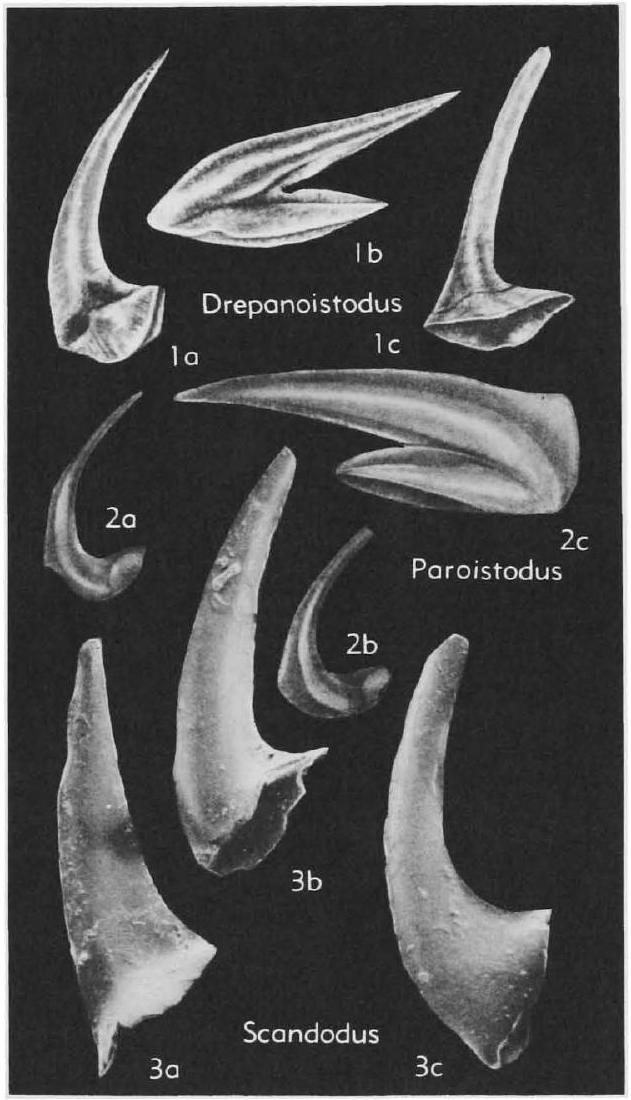Welcome to the Treatise on Invertebrate Paleontology!
Please enter a genera name to retrieve more information.

Paroistodus
Classification
Phylum:
Conodonta
Class:
Conodonta
Order:
Conodontophorida
Superfamily:
Distacodontacea
Family:
Drepanoistodontidae
Formal Genus Name and Reference:
Paroistodus LINDSTRÖM, 1971, p. 46
Type Species:
Oistodus parallelus PANDER, 1856, p. 27, OD
Images
(Click to enlarge in a new window)
Fig. 91, 2. *P. parallelus (Pander), L.Ord. (low.Arenig.), Eu. (Sweden), 2 a, b, nongeniculate elements, lat. views, 2 c, geniculate element, lat. view, X49 (Van Wamel, 1974).
Synonyms
Geographic Distribution
Eu.-N.Am.-S.Am.
Age Range
Beginning Stage in Treatise Usage:
L.Ord., ?M. Ord.
Beginning International Stage:
Tremadocian
Fraction Up In Beginning Stage:
0
Beginning Date:
486.85
Ending Stage in Treatise Usage:
M. Ord.
Ending International Stage:
Darriwilian
Fraction Up In Ending Stage:
100
Ending Date:
458.18
Description
Apparatus bimembrate, Geniculate elements with reclined cusp and anteroposteriorly extended base tending to be square in lateral view, Nongeniculate elements with recurved cusp, cusp in some elements more or less strongly costate, Prominent zone of recessive basal margin commonly developed at anterobasal corner, Basal cavity relatively shallow. [Paroistodus is similar to Drepanoistodus and Paltodus; for discussion of distinguishing characteristics, see LINDSTROM, 1971. Apparatus reconstruction: LINDSTROM, 1971.]
References
Ziegler, Willi, , & Lindström, Maurits, 1971, Über Panderodus Ethington, 1959, und Neopanderodus n. g. (Conodonta) aus dem Devon: Neues Jahrb. Geol. Palacontol. Monatsh., Jahrg. 1971, no. 10, p. 628640, 3 text-fig.
Museum or Author Information
Classification
Phylum:
Conodonta
Class:
Conodonta
Order:
Conodontophorida
Superfamily:
Distacodontacea
Family:
Drepanoistodontidae
Formal Genus Name and Reference:
Paroistodus LINDSTRÖM, 1971, p. 46
Type Species:
Oistodus parallelus PANDER, 1856, p. 27, OD
Images
(Click to enlarge in a new window)
Fig. 91, 2. *P. parallelus (Pander), L.Ord. (low.Arenig.), Eu. (Sweden), 2 a, b, nongeniculate elements, lat. views, 2 c, geniculate element, lat. view, X49 (Van Wamel, 1974).
Synonyms
Geographic Distribution
Eu.-N.Am.-S.Am.
Age Range
Beginning Stage in Treatise Usage:
L.Ord., ?M. Ord.
Beginning International Stage:
Tremadocian
Fraction Up In Beginning Stage:
0
Beginning Date:
486.85
Ending Stage in Treatise Usage:
M. Ord.
Ending International Stage:
Darriwilian
Fraction Up In Ending Stage:
100
Ending Date:
458.18
Description
Apparatus bimembrate, Geniculate elements with reclined cusp and anteroposteriorly extended base tending to be square in lateral view, Nongeniculate elements with recurved cusp, cusp in some elements more or less strongly costate, Prominent zone of recessive basal margin commonly developed at anterobasal corner, Basal cavity relatively shallow. [Paroistodus is similar to Drepanoistodus and Paltodus; for discussion of distinguishing characteristics, see LINDSTROM, 1971. Apparatus reconstruction: LINDSTROM, 1971.]
References
Ziegler, Willi, , & Lindström, Maurits, 1971, Über Panderodus Ethington, 1959, und Neopanderodus n. g. (Conodonta) aus dem Devon: Neues Jahrb. Geol. Palacontol. Monatsh., Jahrg. 1971, no. 10, p. 628640, 3 text-fig.
